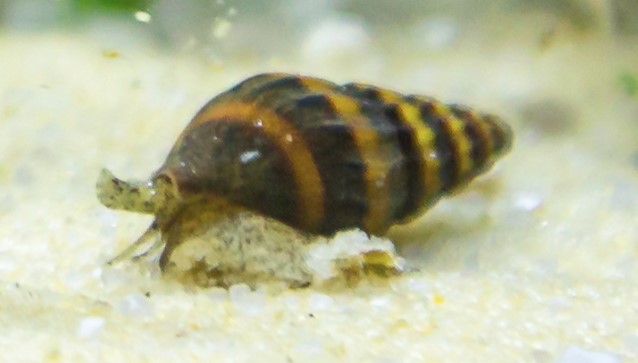I’ve seen many aquarists freak out when they find dozens of snails on their tank glass. Nano aquarium snails can quickly go from being helpful to overwhelming. It happens fast.
Clint from SnailMight, based in Alabama, deals with this issue a lot. He knows that small tank snail control is key when space is tight.
The main troublemakers are bladder snails, ramshorn snails, and Malaysian trumpet snails. They sneak into your tank on live plants or hide in fish bags. Once they’re there, they multiply fast.
But here’s the good news: these “pest snails” are actually good for your tank. They eat algae, clean up leftover food, and break down waste. Some even serve as a snack for snail-eating fish.
The problem is keeping their numbers in check before they take over your small setup. I’ll share effective ways to keep things balanced without getting rid of them all.
Understanding Snail Overpopulation in Small Aquariums
When I first started helping customers with snail problems, I noticed small tanks had the worst infestations. Most aquarists don’t realize how quickly snails multiply in confined spaces. What starts as a few harmless snails can become hundreds within weeks.
Snails reproduce at alarming rates due to three key biological factors. First, they lay egg sacs containing dozens of eggs at once. Second, many species reach sexual maturity in just 35 days. Third, most aquarium snails are hermaphrodites capable of asexual reproduction.

The hermaphroditic nature makes aquarium snail removal challenging. A single snail can clone itself without needing a mate. This means even one surviving snail can restart the entire population.
Small aquariums amplify these problems significantly. Limited water volume means even modest population increases become visually overwhelming. I’ve seen 10-gallon tanks with over 200 snails covering every surface.
Overpopulation typically stems from two main causes:
- Overfeeding – Excess food provides abundant nutrition for rapid reproduction
- Poor maintenance – Decaying plant matter and debris create additional food sources
My customers often describe the same scenario. They notice a few snails, think they’re beneficial, then suddenly discover their tank is overrun. The tipping point happens fast in nano tanks because bioload concerns become critical quickly.
Effective pest snails identification early prevents these population explosions. Once you understand their reproduction patterns, you can take action before they overwhelm your small aquarium ecosystem.
Identifying Common Snail Species in Nano Tanks
Knowing which snail species you’re dealing with is key to small tank snail control. I’ve found that three main species cause most problems in nano aquariums. Each has unique traits that help you identify them quickly.
Bladder snails are the most common invaders I encounter. They have teardrop-shaped gray shells with yellow spots. These hermaphroditic creatures grow to about half an inch and reproduce without a mate. You’ll notice them gliding across glass surfaces during the day. They live up to two years and multiply fast.

Malaysian trumpet snails present different challenges. Their cone-shaped cream or brown shells reach one inch long. These nocturnal diggers hide in substrate during daylight hours. They’re livebearers that give birth to fully formed young. Watch for small cone shells poking from gravel at night. They can live up to 3.5 years.
Ramshorn snails are easy to spot with their distinctive round spiral shells. They come in various colors and grow to one inch. Like bladder snails, they’re hermaphroditic and reproduce asexually. You’ll see them actively feeding on algae during the day. They have the shortest lifespan at about one year.
Understanding these differences helps you choose the right snail population management strategy. Each species responds differently to control methods based on their behavior patterns and reproduction habits.
Prevention Strategies Before Snails Take Over
The best way to stop snails from taking over is to keep them out of your tank. Most snail prevention methods start with live plants. Snails and their eggs often hide on these plants.
Plants from stores can bring snails or eggs. Look for tiny, clear jelly-like sacs on leaves and stems. Always check new plants under bright light before adding them to your tank.
Quarantine tanks are a top choice for prevention. Create a separate tank for new plants. Watch them for 1-4 weeks to catch any snails.
Some people use bleach to prevent snails. Mix one part bleach with twenty parts water. Dip plants for 30 seconds, then rinse well. But, this can harm some plants.
Tissue culture plants are a snail-free option. These plants are grown in labs and cost more. But, they’re perfect for nano tank owners who want no snails.
Prevention isn’t just about plants. Clean all equipment, decorations, and substrate before using them. Even a small piece of gravel can have snail eggs. Taking these steps now saves a lot of time later.
Manual Removal Techniques for Small Aquariums
Manual snail removal is the best way to control nano aquarium snails in small tanks. It gives quick results, unlike other methods that take weeks.
Fine-tipped tweezers are perfect for removing snails in tight spots. Stainless steel tweezers with curved tips are great for getting behind decorations and plants. For bigger snails, use your hands after rinsing them to avoid contamination.
Siphon hoses are great for catching snails during water changes. Just vacuum them up into a bucket. This method is good for pond snails and ramshorn snails that stick to glass.
Malaysian trumpet snails are tough to get rid of because they can survive for months without water. I catch them at night when they come out to eat.
Snail traps with vegetable bait are very effective in small tanks. Just put lettuce or cucumber slices in the tank overnight. In the morning, you’ll find them full of snails.
| Removal Method | Best For | Efficiency | Tank Size |
|---|---|---|---|
| Tweezers | Precision work | High | All sizes |
| Hand picking | Large snails | Medium | 5+ gallons |
| Siphon removal | Small clusters | High | All sizes |
| Baited traps | Mass collection | Very High | 2+ gallons |
Timing your snail removal is key. I do most of it in the evening when the snails are most active.
Natural Predators That Work in Nano Tanks
Using snail-eating species can solve overpopulation issues. Pea puffers are the top choice for controlling snails in small tanks. They are tiny, growing no more than one inch long.
Pea puffers hunt snails very well. They keep snail numbers down by always looking for food. Eating snail shells helps them keep their teeth from growing too long.
Dwarf chain loaches and zebra loaches are great for community tanks. They eat small snails without bothering other fish. Corydoras catfish also help control snail numbers, but they prefer softer snails.
Assassin snails are a special way to control snails. They eat other snails and grow to about one inch. They won’t take over small tanks.
Before adding predators, figure out the right numbers. One pea puffer can handle snails in tanks up to 10 gallons. Start with two assassin snails for every 5 gallons.
Clint from SnailMight says it’s important to think about who gets along. Make sure the predators won’t hurt shrimp or peaceful fish. Feeding them right keeps them hunting without being mean to others.
How to Control Snail Populations in Small Aquariums Using Chemical Methods
Chemical snail control should be a last resort. These methods are risky, affecting small water volumes greatly.
Dead snails from these treatments harm water quality. They decompose fast, causing ammonia and bacterial blooms. In nano tanks, this can be deadly in hours.
Most chemicals don’t kill all snails or their eggs. Surviving snails eat the dead, leading to more snails. It’s key to identify pests before treating.
Clint from SnailMight says use chemicals only when needed. He suggests copper treatments but warns of dangers to loaches and shrimp.
When using chemicals in small tanks, dose carefully. Cut the recommended amount by 25% for tanks under 10 gallons. Watch for signs of fish stress and change the water if needed.
Water conditioners can reduce copper’s effect. For best snail control, mix different methods, not just chemicals.
| Chemical Type | Effectiveness | Risk Level | Tank Size Limit |
|---|---|---|---|
| Copper Sulfate | High | Very High | 10+ gallons |
| Potassium Permanganate | Medium | High | 5+ gallons |
| Commercial Snail-Away | Medium | Medium | 2+ gallons |
| Salt Treatment | Low | Low | Any size |
Long-term Maintenance and Population Management
The best way to manage snail population is to prevent their food sources. This means stopping them before they start. It’s better to prevent snail overpopulation than to fight it all the time.
Feeding your fish right is key. Give them only what they can eat in two to three minutes. Then, take out any leftover food to stop it from rotting and feeding snails.
Keeping up with regular maintenance helps keep snail numbers down. Vacuum your gravel every week to get rid of waste that snails eat. Also, clean algae off glass and decorations before it grows too much.
Looking after your plants is important for aquarium maintenance snails control. Cut off any dead or dying plant parts right away. Snails love to eat dead plants, which helps them multiply.
Water changes are also crucial. They remove nutrients that snails eat. For nano tanks, do 20-25% water changes weekly to keep the water clean and reduce food for snails.
Watch your tank closely for signs of too many snails. Small numbers of snails can actually help your aquarium by eating algae and waste. The goal is to find a balance, not to get rid of all snails.
Seasons change how active snails are. In warmer months, they eat more and plants grow faster. So, you might need to clean more often to keep snail numbers in check.
Conclusion
I’ve shared many ways to keep nano aquarium snails in balance. These creatures are vital to your tank’s health. They eat waste, clean algae, and show when water quality changes.
To control snail numbers, start with prevention. Quarantine new items for your tank. Watch how much you feed to stop them from growing too much. If snail numbers get too high, use natural methods like assassin snails or certain fish.
Clint from SnailMight teaches us to work with nature, not against it. A few snails help keep your tank clean and balanced. But, too many snails can cause problems from overfeeding or neglect.
Success comes from watching your tank closely and acting fast. Check it often. Remove too many snails if needed. Keep feeding and water quality right.
With the right care, small aquariums can be beautiful and balanced. Snails can be a big help. Use the tips I shared to keep your nano aquarium thriving.







